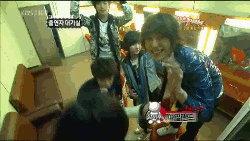가지 마 한 마딜 못한다 이 바보가...
There are any 2 ways for making negative statement. 1st is using refuse particles, 안 (no) and 못 (can’t), and 2nd is using auxiliary, 지 말다 (stop or don’t).
1. Particle 안/못
This particle can only
be used for declarative and interrogative sentences.
Example: - 학교에 안 가요 = I don’t go to school
- 학교에 안 가요? = You
don’t go to school?
- 어제 밤도 못 잤어요 = Last night i couldn’t sleep too
- 어제 밤도 못 잤어요? = Last night you couldn’t sleep too?
- 학교에 안 가십시다! (X)
- 학교에 안 가십시오 (X)
The examples that i
give (X) sign are incorrect because they’re exclamatory and imperative sentences.
안 can be used for verb and adjective, while 못 can
only be used for verbs because this particle shows the inability.
Example: - 비싸다 = expensive
- 못 비싸다 = can’t
expensive (X)
But not every
adjective and verb can use this particle. Some of them already have
negative form, for example 알다 with 모르다, 있다 with 없다 and 맛있다 with 맛없다.
선택 같은 걸없어...
When making negative form for combined verb (noun+하다), we just have to put the refuse particles in front of 하다.
Example: - 이제는 생각 안 해요 = I don’t
think now
- 이제는 생각 못 해요 = I can’t think now
2. Particle 지 않다 and 지 못하다
These particles have
the same meaning with previous particles, but these particles are commonly used
for formal conversation. They can be used for adjective and verb. When 못 be paired with adjective, the
statement depicts disappointment of the speaker and the particle means ‘not’
instead of can’t.
Example: - 배우지 않아요 = I don’t study
- 떠나지 못해요 = I
can’t leave
- 덥지 않아요 = It’s
not hot
- 토마스가 건강하지 못해요 =
Regrettably Thomas is not well
Same with previous
particles, these particles can only be used for declarative and interrogative sentences too.
Example: - 학교에 가지 않아요 = I don’t go to school
- 학교에 가지 않아요? = You
don’t go to school?
- 어제 밤도 잠들지 못했어요 = Last night i couldn’t sleep too
- 어제 밤도 잠들지 못했어요? = Last night you couldn’t sleep too?
- 학교에 가지 않으십시오 (X) »
Order statement
- 학교에 가지 않으십시다!
(X) »
Allurement
3. Particle 지 말다
This particle is used to state our disagreement or contradiction over anything. And this particle can only be used for imperative and exclamatory sentences.
Example: - 그 고기를 먹지 말아요! = Don’t
eat that meat!
- 여기서 들어오지 말아요 = Don’t
come here!
- 그 집에를 들어오지 마십시오! = Don’t enter that house
- 길에서 놀지 말고 집에서 놀자 = Don't play in the street, play in the house instead
- 여기서는 담배를 피우지 마십시오! = Don't smoke in here!
- 여기서는 담배를 피우지 마십시오! = Don't smoke in here!















